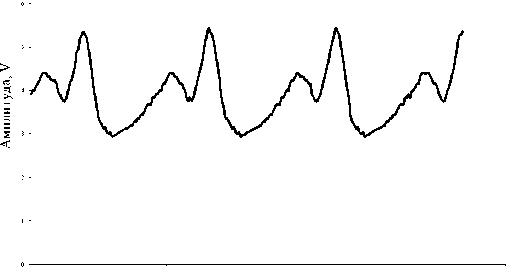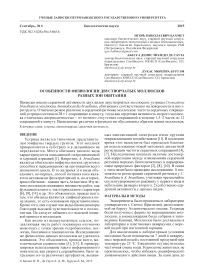Особенности физиологии двустворчатых моллюсков разных зон обитания
Автор: Бахмет Игорь Николевич, Де Сауза Абесса Денис Моледо, Буруэм Лукас Морейра
Журнал: Ученые записки Петрозаводского государственного университета @uchzap-petrsu
Рубрика: Биология
Статья в выпуске: 6 (151), 2015 года.
Бесплатный доступ
Проведен анализ сердечной активности двух видов двустворчатых моллюсков: устрицы Crossastrea brasiliana и моллюска Anomalocardia brasiliana, обитающих соответственно на поверхности и внутри грунта. Отмечено резкое различие в сердечной ритмике моллюсков: частота сердечных сокращений устрицы составила 28 ± 1 сокращение в минуту, тогда как сердечная активность второго моллюска отличалась апериодичностью - от полного отсутствия сокращений в течение 1,5-2 часов до 12 сокращений в минуту. Выявленные различия в физиологии обусловлены образом жизни моллюсков.
Устрица, аномалокардиа, сердечная активность
Короткий адрес: https://sciup.org/14750956
IDR: 14750956
Текст научной статьи Особенности физиологии двустворчатых моллюсков разных зон обитания
Устрица является типичным представителем эпифауны твердых грунтов. Этот моллюск прикрепляется к субстрату и в дальнейшем не передвигается. Места обитания данного вида характеризуются повышенной гидродинамикой и хорошей аэрацией [1]. Напротив, A. brasiliana является обитателем инфауны мягких грунтов и способна к передвижению на протяжении всего жизненного цикла. В то же время эти виды объединяет, во-первых, способ питания (они являются активными фильтраторами) и, во-вторых, ареал обитания – южная часть Атлантики. Изучению моллюсков посвящено множество работ, как фундаментального, так и прикладного характера [6], [9], [14] и др. Это объясняется, прежде всего, тем, что оба вида являются эдификаторами в популяциях, то есть основными представителями. Кроме того, они служат как виды-биоиндикаторы благодаря высокой чувствительности к поллютантам. Не следует забывать и о высокой пищевой ценности моллюсков.
Как видно из вышеуказанных ссылок, подавляющая часть работ посвящена изучению животных с точки зрения гидробиологии, экологии, биохимии и токсикологии. Исследованию же физиологии данных моллюсков не уделялось внимания. Это объясняется, прежде всего, методическими сложностями [5], [13]. К примеру, широкое использование такого информативного показателя, как скорость сердцебиения, было затруднено из-за различных артефактов, вызван
ных имплантацией электродов и/или другими повреждающими воздействиями [11]. В последнее время этот недостаток был преодолен благодаря использованию новой методики дистантной региcтрации частоты сердечных сокращений [4], [7]. Исследования показали наличие достоверной корреляции между изменениями сердечной ритмики морских беспозвоночных и варьированием природных факторов [2], [8], [10]. В связи с этим нами было проведено исследование: 1) возможности регистрации сердечной ритмики у C. brasiliana и A. brasiliana , учитывая чрезвычайно скульптурированную раковину у первого вида и небольшие размеры второго; 2) собственно сердечной активности у данных видов.
МАТЕРИАЛЫ И МЕТОДЫ
Эксперименты были проведены в лаборатории университета г. Сантос (Бразилия), расположенной на берегу Атлантического океана. Устрицы были получены с фермы по выращиванию моллюсков, а аномалокардиа была собрана в заповеднике Кананеа. Моллюски были доставлены в лабораторию в пластиковых аквариумах с морской водой при постоянной аэрации.
Для акклимации к лабораторным условиям моллюски были помещены на 7 дней в аквариумы с морской водой с постоянной продувкой при температуре 25 оС. Ежедневно осуществлялась частичная смена воды. Кормление животных не производилось, чтобы избежать специфического динамического действия пищи. За один день до эксперимента к раковинам моллюсков в район предполагаемого размещения перикарда были приклеены оптические сенсоры CNY-70, после чего 15 аномалокардий (средняя длина раковины 29,0 ± 0,3 мм) и 15 устриц (средняя длина раковины 71,3 ± 2,1 мм) были помещены в два отдельных аквариума при тех же условиях.
Через сутки была проведена регистрация сердечной активности моллюсков в течение суток. Использовалась методика дистантной записи сердечной активности, основанная на излучении инфракрасного света в область расположения сердца и регистрации отраженных лучей [4].
РЕЗУЛЬТАТЫ
Для получения стабильной записи сердечной ритмики в раковине устрицы мы выпиливали квадратное углубление (глубиной около 2 мм). После нескольких попыток было определено точное место расположения перикарда, которое находится на пересечении двух линий: первая – от umbo до края раковины; вторая – перпендикулярно первой на расстоянии 40 мм от umbo. В случае же аномалокардии место прикрепления датчика находилось на расстоянии 5–6 мм от umbo.
В результате проведенных экспериментов были получены четко выраженные плетизмо-граммы как у C. brasiliana , так и у A. brasiliana (рисунок). На графике достаточно легко различимы сокращения предсердий (более длительный и менее выраженный пик) и желудочка (более короткий по времени и высокий пик). В то же время сердечная активность устрицы резко отличалась от сердечной ритмики аномалокардии по характеру и частоте сердечных сокращений (ЧСС). ЧСС первого вида варьировала на протяжении суток от 26 до 29 сокращений в минуту и составила в среднем 28 ± 1.
Сердечная активность аномалокардии изменялась от 0 (то есть полная остановка сердечных сокращений) до 12 сокращений в минуту. Периоды покоя длились от 1 минуты до 2 часов. Никакой периодической зависимости в появлении акардии обнаружить не удалось.
ОБСУЖДЕНИЕ
Хотелось бы подчеркнуть, что нам впервые удалось успешно применить методику дистантной регистрации сердечной активности C. brasiliana и A. brasiliana . Полученный результат показал ярко выраженные различия в сердечной ритмике данных видов. Прежде всего это проявилось в выраженной стабильности ЧСС устрицы в отличие от аномалокардии. Особенно подчеркнем апериодическую акардию, наблюдавшуюся у A. brasiliana . Данный факт может свидетельс-

Время, сек
Пример стандартной плетизмограммы устрицы и аномалокардии твовать о резких изменениях уровня метаболизма. Сходная вариабельность уровня потребления кислорода была отмечена у моллюска Arctica islandica, который также является типичным представителем инфауны мягких грунтов [3]. Более того, сердечная активность этого вида также апериодически останавливалась, причем периоды акардии иногда длились более суток [12]. Данный феномен приводит к тому, что у инфаунных моллюсков резко снижена скорость роста. К примеру, в нашем случае самые крупные экземпляры аномалокардии не превышали 32 мм (длина раковины), тогда как раковина устрицы или мидии достигает сходной длины в течение одного года.
Причины пониженного и нестабильного уровня метаболизма у инфаунных моллюсков пока неясны. Одна из возможных причин может заключаться в недостатке пищи, поскольку в условиях инфауны водные потоки снижены по сравнению с эпифауной. Следовательно, скорость доставки фито- или зоопланктона также незначительна. Кроме того, небольшие размеры позволяют моллюскам легче передвигаться в толще грунта.
В заключение хотелось бы остановиться на возможности использования сердечной ритмики C. brasiliana и A. brasiliana при биотестировании природных вод. Исходя из характера сердечной активности данных видов, можно сделать вывод, что стабильная сердечная активность устрицы хорошо подходит для отслеживания изменения параметров окружающей среды, в отличие от аномалокардии. Несомненно, для успешного применения данного параметра необходимы токсикологические эксперименты для оценки чувствительности устрицы к различным поллютантам.
Выражаем признательность сотрудникам ББС ЗИН РАН «Картеш» за неоценимую помощь при проведении экспериментов.
Особенности физиологии двустворчатых моллюсков разных зон обитания
Список литературы Особенности физиологии двустворчатых моллюсков разных зон обитания
- Жирков И. А. Жизнь на дне. Био-экология и био-география бентоса. М.: МГУ, 2010. 453 с.
- Bakhmet I. N., Berger V. Ja., Khalaman V. V. The effect of salinity change on the heart rate of Mytilus edulis specimens from different ecological zones. J. Exp. Mar. Biol. Ecol. 2005. Vol. 318 (2). Р. 121-126.
- Begum S., Basova L., Strahl J., Sukhotin A., Heilmayer O., Philipp E., Brey T., Abele D. A metabolic model for the ocean quahog Arctica islandica -effects of animal mass and age, temperature, salinity, and geography on respiration rate. J. Shellf. Res. 2009. Vol. 28 (3). P. 533-539.
- Depledge M. H., Andersen B. B. A computer-aided physiological monitoring system for continuous, long-term recording of cardiac activity in selected invertebrates. Comp. Biochem. Physiol. 1990. № 96. Р. 474-477.
- Depledge M. H., Amaral-Mendes J. J., Daniel B., Halbrook R. S., Kloepper-Sams P., Moore M. N., Peaka 11 D. B. The conceptual basis of the biomarker approach. D. B. Peakall and L.R. Shugart (eds.) Biomarkers: Research and application in the assessment of the environmental health. NATO ASI Series H: Cell Biology. 1992. Vol. 86. P. 15-29.
- Lannig G., Flores J. F., Sokolova I. M. Temperature-dependent stress response in oysters, Crassostrea virginica: pollution reduces temperature tolerance in oysters. Aquat Toxicol. 2006. Vol. 79. P. 278-287.
- Marshall D. J., McQuaid C. D. Differential physiological and behavioural responses of the intertidal mussels, Choromytilus meridionalis (Kr.) and Pernaperna L., to exposure to hypoxia and air: a basis for spatial separation. J. Exp. Mar. Biol. Ecol. 1993. Vol. 171 (2). P. 225-237.
- Marshall D. J., McQuaid C. D. Seasonal and diel variations of in situ heart rate of the intertidal limpet Siphonaria oculus Kr. (Pulmonata). J. Exp. Mar. Biol. Ecol. 1994. Vol. 179 (1). P. 1-9.
- Narchi W. Comparative study of the functional morphology of Anomalocardia brasiliana (Gmelin, 1791) and Tivela mactroides (Born, 1778) (Bivalvia, Veneridae). Bull. Mar. Sci. 1972. Vol. 22 (3). P. 643-670.
- Santini G., Williams G. A., Chelazzi G. Assessment of factors affecting heart rate of the limpet Patella vulgata on the natural shore. Mar. Biol. 2000. Vol. 137 (2). P. 291-296.
- Segal E. Acclimation in mollusks. Amer. Zoologist. 1961. Vol. 1 (2). P. 235-244.
- Taylor A. C. Burrowing behaviour and anaerobiosis in the bivalve Arctica islandica (L.). J. Mar. Biol. Assoc. UK. 1976. Vol. 56. P. 95-109.
- Taylor L. N., Mc Ge e r J. C., Wood C. M., McDonald D. G. Physiological effects of chronic cooper exposure to rainbow trout (Oncorhynchus mykiss) in hard and soft water: evaluation of chronic indicators. Environ. Toxicol. Chem. 2000. Vol. 19. P. 2298-2308.
- Yamagishi H., Uesaka H., Ebara A. Phase-response analysis of stretch-mediated beat coordination in the oyster heart. II. Mutual entrainment of auricle and ventricle. Zool. Sci. 1995. Vol. 12. P. 405-409.


